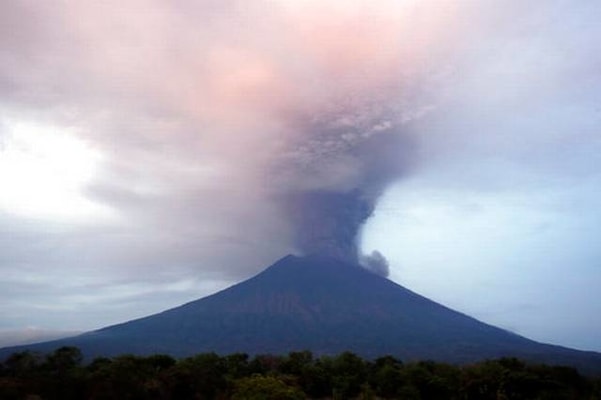
A volcano in Indonesia has been playing a game of whether or not it’s going to erupt for months now. The volcano pushed a large cloud of ash into the atmosphere this weekend, adding to this game. The dual-colored plume of ash rose up to 30,000 feet into the sky, making for spectacular images, but scientists are still gathering data to see if it will lead to something bigger. If the volcano does become more active, it could do more than cancel flights and incinerate rainforests. It could give the world a brief reprieve from the planetary heat wave of global warming. Are you listening global warming deniers?
Does this mean that the volcano could erupt? Would it be something like the 1963 eruption that killed 1,000 people? Or is everything going to return to normal, and this was nothing more than a warning cry? Well, Indonesia’s Center for Volcanology and Geological Hazard Mitigation has raised its warning level to red, which is the highest alert possible, and they have evacuated more than 75,000 people living in proximity of the volcano. At this point, however, it’s a “wait and see” process. Which is too bad, but what else can be done at this point?

There are two big questions looming with this. The first is – will this volcano actually erupt? And what happens if the volcano erupts? The first one is asking from an immediate concern perspective. The second question is about long-term effects and impacts. While there aren’t really any answers to either one of those questions, this is what we do know: Explosive volcanic eruptions can send ash plumes high into the stratosphere. In the immediate vicinity, the ash can fall back from the sky and cause breathing problems or dangerous mudflows if it mixes with rain. But tiny particles of sulfur dioxide in the plume can also linger in the stratosphere. There, they reflect sunlight back into space and cool the climate for a few years before falling back to Earth.

Large eruptions can also slow other aspects of climate change. Which means that this might not be a bad thing – in the long term. And if you don’t live near the volcano. (And if you do, I apologize for my characterization that this might not be a bad thing.) The big “if” with this sulfur dioxide scenario is that in order for it to be beneficial, the sulfur dioxide needs to reach the stratosphere. While satellites have shown sulfur dioxide in Bali’s ash cloud, the cloud is only about halfway to the stratosphere at this point. That means its climate impact is negligible so far. But if the ash cloud rises higher and becomes more potent, its climate impacts would be felt fairly quickly.
There are two things to consider with this idea of cooling. The first is that this volcano is relatively small, so it may not have a large-scale impact like we might want or even hope. The second idea is that the amount of cooling is likely to be minimal given the size of the volcano. If Yellowstone, for example, were to erupt, we might have a different outcome. This isn’t something we should even get our hopes up about.



